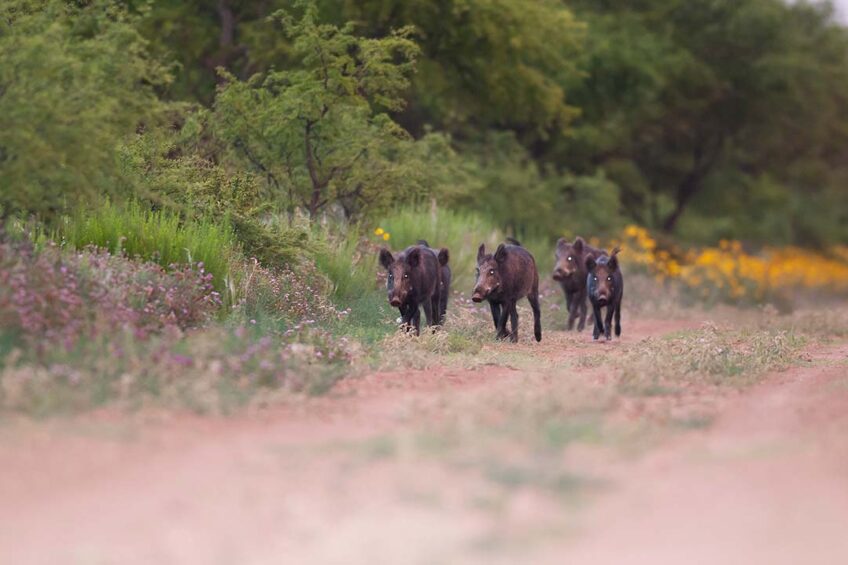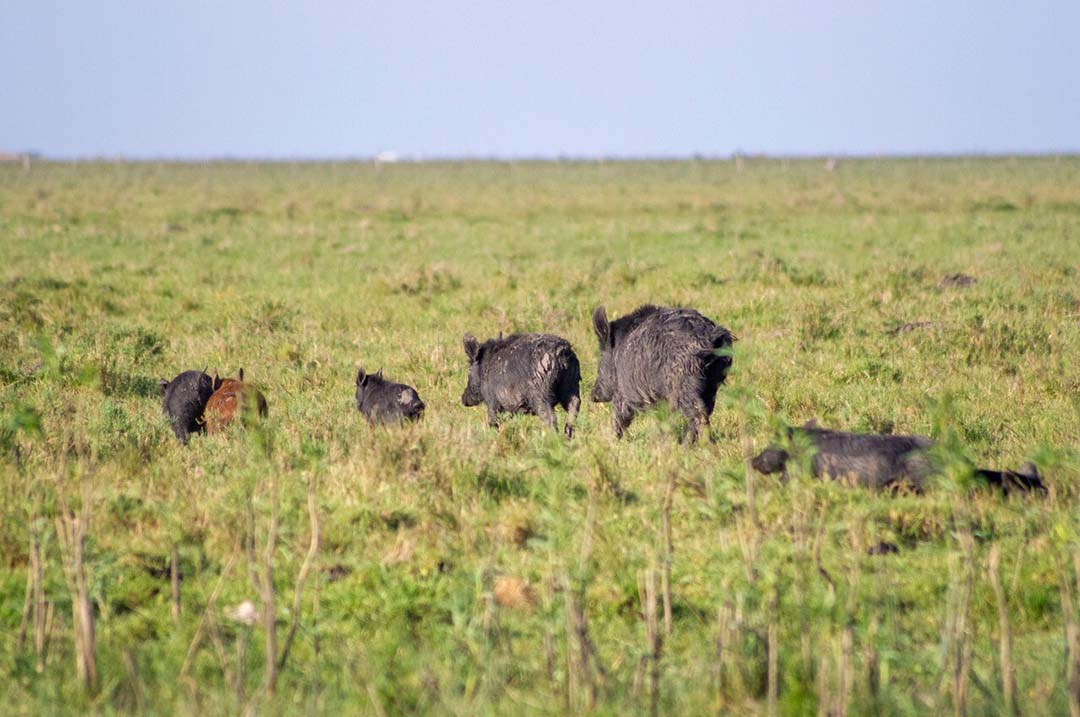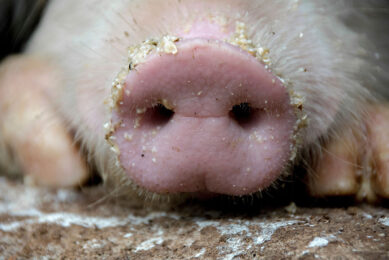Should piglets be eating more like their ancestors?

Pre-weaning diets these days consist of dairy products, processed cereals, fats of vegetable and animal origin and processed plant proteins. They help a piglet grow fast but do they help piglets’ gastro-intestinal tract to mature? In order to find that answer, in an unprecedented study, Dr Hubèrt van Hees zoomed in on what feral piglets consume in their first weeks.
The quest for economical diets that benefit farmers and their weaning piglets has been ongoing since the early days of commercial pig husbandry. But whilst there has been an enormous amount of research into formulation of commercial weaning diets, with diets varying in levels of many components from fibre to fat to protein, these formulations have been based only on suppositions about what’s best for the piglet’s gastro-intestinal tract (GIT) development and overall development.
That is, wouldn’t it be informative to look at what piglets in the wild actually eat, and the effect of those diets on the same factors, perhaps resulting in better formulations than the ones that have so far been created?
Today’s commercial pigs are like their ancestors
Dr Hubèrt van Hees has begun to answer this question definitively. With several colleagues, he began studying the topic several years ago and from different angles. He finished his doctorate at Ghent University in Belgium in 2022. He has been working for Trouw Nutrition in the Netherlands since 1995, and he is now manager of swine research.
Van Hees notes that today’s commercial pigs are very much like their ancestors. “By studying the effects of the normal diet of wild piglets on GIT and overall development, we can see how much our commercial diets differ and how they might be modified to result in better outcomes for weaning pigs. A similar approach has been taken in optimising cat food formulations for adult cats.”

Origins of research
In terms of how his PhD came about, Van Hees explains that prior to its start, he had been in contact with a researcher named Dr Sebastian Ballari in Argentina. They decided together it would be worthwhile to study the diets and development of feral piglets there, the descendants of pigs that had been released about 500 years ago by explorers from Spain.
“In a natural setting, domestic pigs undergo a feralisation process and subsequently recover aspects of the body and behaviour of their wild boar ancestry,” Van Hees explains. “It is therefore likely that many features in their nutrition, such as feed item preference and preferred macronutrient profile, digestive and absorptive mechanisms and nutrient metabolism, still reflect that of wild pigs.”
What do feral piglets eat?
In the wild, pigs are omnivorous, eating both animal and plant material. Both the adults and juveniles consume various sources of food available throughout the seasons in their geographical location. Adult feral pigs mostly eat plant matter, but given the opportunity, will also eat insects, invertebrates, eggs, rodents and birds.
We knew feral piglets follow their mother on foraging trips outside the nesting site and start rooting behaviour and chewing on various items during their first week of life
But feral piglets? There has not been much study of what they eat under free-ranging conditions, says Van Hees. “We knew feral piglets follow their mother on foraging trips outside the nesting site and start rooting behaviour and chewing on various items during their first week of life. When we started the study it was not clear, however, whether they were actually ingesting solid matter during these initial weeks.”
Dietary fiber
By investigating further, Van Hees and his colleagues aimed to confirm whether wild piglets eat much plant material early in their lives. This means they are taking in some (or a lot) of dietary fibre. This may help spur the process of maturation of the intestinal system and the start of gradual weaning at the typical age of eight to 17 weeks.
If that was the case, then “in this respect, the natural diet would appear quite distinct from a typical supplemental diet commonly fed to farmed pigs, especially in relation to dietary fibre level,” he explains.
Their goal was clear: find out what feral piglets eat, how much dietary fibre is consumed early in life and whether or not the early intake of dietary fibre is beneficial for GIT maturation in the pre-weaning feral piglet.
Development of the gut
Piglets are born with a GIT able to respond to differing diets, for better or for worse. As everyone in pig husbandry is aware, suckling commercial piglets are offered supplemental milk replacers and dry feed (“creep feed”) to prepare them for weaning. These diets are nutrient-dense, highly digestible, highly palatable, very low in dietary fibre and very finely-milled.
These commercial piglet diets contain a variety of ingredients, mainly dairy products, processed cereals, fats of vegetable and animal origin and processed plant proteins. In many cases, these ingredient mixtures are finely-ground and formed into small pellets. Compaction during the pelleting process improves nutrient digestibility.
It is very common that piglets in a commercial setting are often prone to gastro-intestinal disorders
Before they got their results, Van Hees and his colleagues noted that these diet characteristics do not necessarily best support healthy GIT development. “After all, it is very common that piglets in a commercial setting are often prone to gastro-intestinal disorders,” he says, “likely originating from a suboptimal feed intake during the days following the weaning event.”
Babying the piglet diet
Commercial piglet diets do not have much dietary fibre, perhaps stemming from a belief that the piglet’ GIT should be “babied.” More specifically, because a pig’s own enzymes cannot degrade dietary fibre, putting dietary fibre in the piglet diet would force the young pig to rely on enzymes from microbes in their intestines before they are ready to take on that big task. Microbial communities that degrade dietary fibre still have to develop, and this is not stimulated by providing low-dietary fibre diets to suckling piglets.
At the same time, the developmental trajectory of the bacterial community is strongly affected by the weaning event, says Van Hees. “Weaning induces major perturbations of the microbiota, resulting in a condition of dysbiosis (a state in which pathogenic microbial species are dominantly present), which brings immunological and metabolic consequences for the host. A state of eubiosis, in which potentially-beneficial species are most abundant, is preferable. More dietary fibre in the diet may support that.”
Study details
In Argentina, Van Hees and his colleagues caught wild piglets (without traps), euthanised them, examined their stomach contents and took body and stomach weights and measurements, among other data. “Working with park rangers, we achieved a large sample population, and made sure the age of the pigs was in the range we were aiming for,” he says. “We also worked on how to interpret the data in a reproduceable manner.”
In the stomach contents, as expected, Van Hees and his team found mostly plant materials that were quite coarse. And the stomachs of these feral piglets were indeed notably more developed when compared to commercially-farmed piglets of a similar age and body weight.
Further research
To test how diets with more dietary fibre might have positive results with commercial piglets, van Hees is working with the same research group in a follow-up project, feeding grass hay and other fibrous ingredients. They have observed better development in small and large intestine at 4 weeks of age, around the time of weaning. In support of their hypothesis, they saw that addition of dietary fibre increased large intestinal size and fill. In addition, in the study freshly weaned piglets fed diets with coarser dietary fibre, i.e. oat hulls, had less stomach aberrations (early signs of stomach ulceration) compared to standard (finely milled, low fibre) diets.
Already we feel we have quite sufficiently proven that young pigs require fibre and coarse particles for the best possible gut development
“It is very exciting to see these results,” says Van Hees. “We will continue working on it, but already we feel we have quite sufficiently proven that young pigs require fibre and coarse particles for the best possible gut development. It is our thinking that giving fibre “pushes” the gut into development. If you do not offer the stomach something to “chew on” so to speak, it will not be stimulated to change. Its development is actually stunted, and that doesn’t get us closer to our goal as an industry of having young pigs adapt to commercial diets as soon as possible.”
More fibre-rich ingredient sources
In studies to come, the team will be looking at more fibre-rich ingredient sources that are most economically feasible to feed to piglets. These include oat hulls, cereal brans and sunflower seed fibre. “Because piglets in the wild are weaned later,” adds Van Hees, “we also look at introducing fibrous diets and courser particles to commercial piglets at different ages.”
Some information from a commercial-scale trial of piglet feeds that are higher in dietary fibre but also containing more coarse particles should be available during the second half of 2024.
In conclusion
The take-aways of this research could cast a new light on nutrition of suckling piglets. Zooming out, Dr Van Hees concludes, “Common practice in pig nutrition was to feed suckling piglets with highly digestible, low-fibre, finely ground diets, such as creep feed and milk supplements. Recent scientific data, among my own, challenge this dogma and indicate coarser dietary fibre is also important for stimulating early development and maturation of the stomach and intestines. Simply put, instead of pampering the yet immature digestive system of the young suckling piglet, it is stimulated to mature. This may improve resilience of piglets, i.e. when challenged by for instance early weaning or intestinal pathogens or sub-optimal diets.
He continues, “It may well be that also other maturational aspects are important, such as developing the fine musculature of the jaw and tongue to allow feeding behaviour and for dental health. Some data point in this direction.
“In short, taking the perspective of the feral pig’s nutrition provides insight and inspiration for improving farmed pig’ nutrition but it cannot be a one-to-one translation. Nutritionists have to balance feed efficiency with health and, obviously, economics.”











